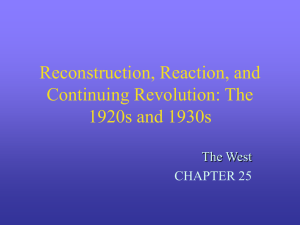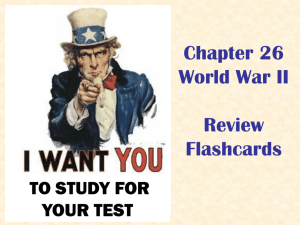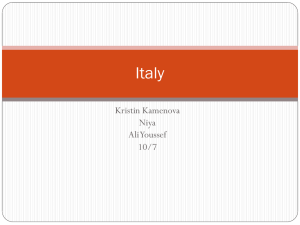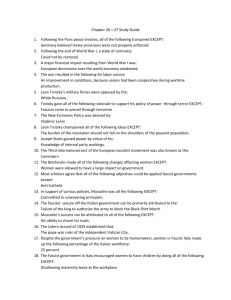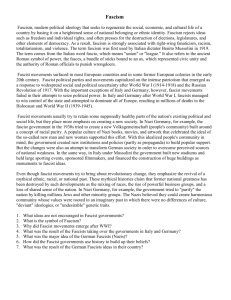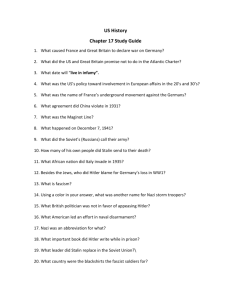Ch.26Questions
advertisement
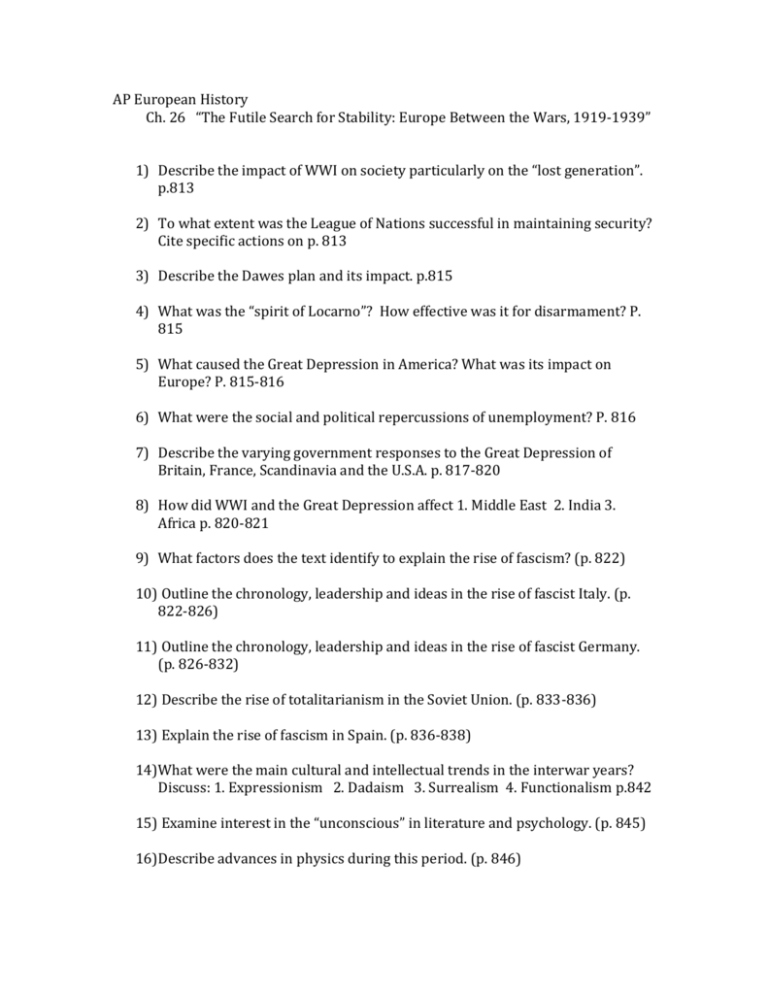
AP European History Ch. 26 “The Futile Search for Stability: Europe Between the Wars, 1919-1939” 1) Describe the impact of WWI on society particularly on the “lost generation”. p.813 2) To what extent was the League of Nations successful in maintaining security? Cite specific actions on p. 813 3) Describe the Dawes plan and its impact. p.815 4) What was the “spirit of Locarno”? How effective was it for disarmament? P. 815 5) What caused the Great Depression in America? What was its impact on Europe? P. 815-816 6) What were the social and political repercussions of unemployment? P. 816 7) Describe the varying government responses to the Great Depression of Britain, France, Scandinavia and the U.S.A. p. 817-820 8) How did WWI and the Great Depression affect 1. Middle East 2. India 3. Africa p. 820-821 9) What factors does the text identify to explain the rise of fascism? (p. 822) 10) Outline the chronology, leadership and ideas in the rise of fascist Italy. (p. 822-826) 11) Outline the chronology, leadership and ideas in the rise of fascist Germany. (p. 826-832) 12) Describe the rise of totalitarianism in the Soviet Union. (p. 833-836) 13) Explain the rise of fascism in Spain. (p. 836-838) 14)What were the main cultural and intellectual trends in the interwar years? Discuss: 1. Expressionism 2. Dadaism 3. Surrealism 4. Functionalism p.842 15) Examine interest in the “unconscious” in literature and psychology. (p. 845) 16)Describe advances in physics during this period. (p. 846) 1.Which one of the following did not characterize the weakness of the League of Nations? a. the failure of the United States to join b. U.S. determination to be less involved in European affairs c. U.S. determination to be more involved in European affairs d. economic sanctions as the League's sole weapon e. failure of the League to reprimand member states for acts of aggression 2.Which of the following helped usher in a new era of European prosperity between 1924 and 1929? a. the French occupation of the Ruhr Valley b. Germany's decision to print extra money c. the system of reparations payments devised in 1919 and foisted on Germany d. American investments following the Dawes Plan e. escalating prices for agricultural goods, leading to better rural finances and consequent government tax revenues 3. The settlement in 1925 by which Germany agreed to accept its border with France was known as the a. Berne Protocol. b. Treaty of Versailles. c. Rapollo Agreement. d. Geneva Accord. e. Treaty of Locarno. 4. A major cause of the Great Depression in Europe was a. European governments were too involved in their own economies. b. the recall of American loans from European markets. c. the underproduction and high prices of agricultural goods in eastern and central Europe. d. the inability of the League of Nations to set complementary economic policies in different global markets. e. Weimar Germany's high tariff policies that prohibited trade with other nations. 5. The first Popular Front government in France a. solved the depression by eliminating workers' benefits. b. gave ordinary workers new rights and benefits including a minimum wage. c. was able to end the problems of economic depression. d. collapsed in 1926, allowing Raymond Poincaré's Cartel of the Left to take power. e. remained in power until the German invasion of 1942. 6. All of the following are correct about the European nations and their colonial empires during the interwar years except a. despite World War I, the Europeans had maintained their colonial empires. b. Britain and France had added to their empires by dividing up many of Germany's colonial possessions. c. the political and social foundations and the self-confidence of European imperialism was strengthened during the 1920s and 1930s. d. the political and social foundations and the self-confidence of European imperialism was undermined during the 1920s and 1930s. e. there was a rising tide of unrest in the colonial world against Western imperialism. 7. The Middle Eastern Muslim nation that made a conscious effort to adopt a Westernized secular culture after World War I was a. Egypt. b. Iraq. c. Saudi Arabia. d. Palestine. e. Turkey. 8. The growth of Mussolini's Fascist movement was aided by a. the reaction against Italy's communist government, formed after World War I. b. popular, nationalistic resentment toward Italy's treatment following World War I. c. crop failures in 1920 and 1921. d. economic cooperation between Italy, Germany, and the Soviet Union. e. the fall of the Italian monarchy and the establishment of a workers' dictatorship. 9. Women in Mussolini's Fascist Italy were a. coerced into factory work to aid industrial production. b. regarded as equal to men in social status. c. largely forced through government legislation to become homemakers. d. aided by the government's emphasis on birth control. e. required under pain of imprisonment to join the Black Shirts. 10. The Lateran Accords of 1929 a. nationalized all church property. b. recognized Catholicism as the sole religion of Italy. c. marked the Catholic church's official condemnation of the Fascist state. d. eliminated government support for the Catholic church. e. turned the property of the Vatican over to the Italian government in exchange for tax reductions. 11. The Nazis proved to be effective in the realm of politics by a. securing many small donations from large German corporations. b. making the Nazi program appeal to every segment of German society. c. persuading the average German that their program was the only alternative to the inept Weimar regime. d. forcing the poorer Germans to vote for Nazi candidates through intimidation. e. unconstitutionally seizing power by force. 12. The Nazi policies toward women a. differed fundamentally from those of Fascist Italy. b. eliminated females from all professional occupations. c. were aimed at bridging the differences between the sexes. d. claimed that through childbearing and service in the home women would bring about the triumph of the Aryan race. e. was to organize all adult women in the German Homemakers Front. 13. The Spanish Civil War ended with the victory of a. King Alfonso XIII and General Miguel Primo de Rivera. b. an antifascist coalition, aided by Soviet troops and supplies. c. the National Front, aided by Italian and German arms and money. d. Francisco Franco, who established a conservative, authoritarian, and antidemocratic regime with the backing of the Spanish Catholic Church. e. the Popular Front. 14. Joseph Stalin's emergence as leader of the Communist party was aided by a. Lenin's recommendation that he become sole leader. b. his alliance with Trotsky and the Right in the Politburo. c. his position as general secretary of the Bolshevik party. d. strong support of the left in the Politburo, which favored the spread of Communism abroad. e. the support of the Soviet military. 15. The Stalinist era in the 1930s witnessed a. the decline of industrialization in favor of the collectivization of agriculture. b. real wages and social conditions for the industrial labor force improve dramatically. c. millions of ordinary citizens arrested and sent into force labor camps. d. an abundance of permissive social legislation. e. an activist foreign and military policy, bent upon immediately making Eastern Europe a satellite region to the Soviet Union. 16. The collectivization of agriculture under Stalin was characterized by a. was a failure, and the peasants quickly returned to their private plots. b. the cooperation of kulaks. c. the destruction of the collective farms. d. immediate financial benefits for most of the peasants. e. widespread famine. 17. The new forms of mass communication and leisure created between the wars included all except a. cinema becoming an increasingly popular form of entertainment. b. Fascist nations them for propaganda purposes. c. radio production and broadcasting companies increasing dramatically. d. the widespread use of television in most middle class homes. e. the automobile becoming a common method of travel for the middle classes 18. "Strength through Joy" a. was one of the most effective Nazi propaganda films to be made by German actors, producers, and directors corrupted by Hitler's ideology. b. was Fascist Italy's most popular national recreation agency. c. monitored and homogenized the leisure time of the German workers. d. failed miserably in its attempts to draw German workers to vacation package tours. e. was Spain's Franco's attempt to emulate the popular propaganda movements of Nazi Germany and Fascist Italy. 19. Artistic and intellectual trends in the inter-war years reflected a. a rejection of the avant-garde. b. a disillusionment with Western Civilization provoked by the horrors of the World War I. c. realistic forms of art, as with the Dadaists. d. an acceptance of modern art forms, especially in Germany and Russia. e. a rediscovery of Romantic Realism as the major art movement in the West. 20.The most famous of the Surrealistic painters was a. Arnold Schonberg. b. Pablo Picasso. c. Walter Gropius. d. Jackson Pollack. e. Salvador Dali. 21. The Dada movement in art was known for all of the following except a. an expressed contempt for Western culture. b. an effort to put a clear sense of purpose and ambition back into art and life. c. "anti-art" and the mockery of all known, traditional forms of artistic expression. d. a celebration of chaos and the absurd, often expressed in bizarre performances and collages of unrelated objects. e. popular in Berlin during the Weimar years. 22.Walter Gropius was best known for his a. "socialist realism" paintings. b. atonal, experimental music. c. revolutionary directions in theater. d. post-modern architectural designs. e. ideas of functionalism in architecture. 23.Culture in Nazi Germany centered around a. the use of modern, abstract forms to reflect Germany's "new order." b. the functionalism of the Bauhaus school. c. petty-bourgeois art, with sentimental and realistic scenes glorifying strong, heroic Aryans. d. religious scenes influenced by Catholic dogma. e. military themes at the expense of all other subjects. 24. Not associated with the new literary techniques of the 1920's was a. the "stream of consciousness." b. James Joyce. c. Herman Hesse. d. Ernest Rutherford. e. Virginia Woolf. 25. The physicist Walter Heisenberg was most noted for a. proposing that uncertainty was at the bottom of all physical laws. b. being among the first team to split the atom. c. resurrecting the scientific predictability of classical physics. d. the development of the atomic bomb. e. correcting Einstein's errors in the latter's theory of relativity. 26. All of the following concepts were central to the psychological theories of Carl Jung except a. the collective unconscious. b. the process of individuation. c. the uncertainty principle. d. universal archetypes. e. the importance of universal myths.
